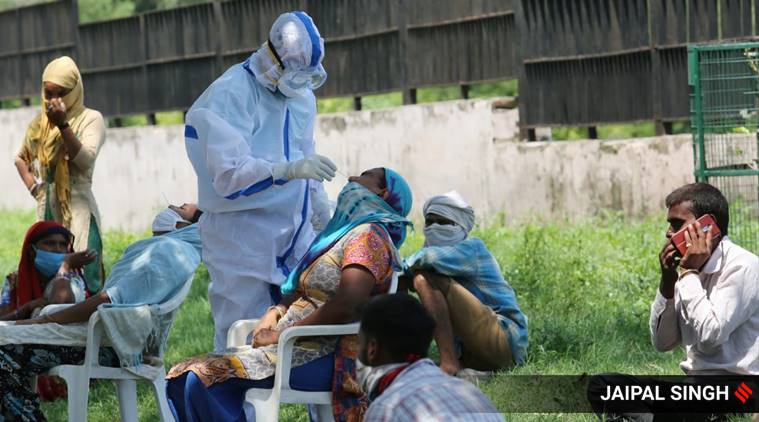 Health team taking samples of residents of Gandhi Colony in Panchkula on Saturday. Jaipal Singh
Health team taking samples of residents of Gandhi Colony in Panchkula on Saturday. Jaipal Singh
Gandhi Colony, a slum with a population of 2,100 living in 485 huts with access to only 20 public bathrooms was turned into a containment zone on Saturday. Although the area has reported only one Covid-19 case yet, the drastic measures have been taken to stop any possible spread of infection in the congested colony.
The area is turning out to be a major challenge for health authorities and residents alike.
The Gandhi Colony slum is divided into three broad lanes, which give way to multiple smaller lanes. Most families, with upto five members, live in raw 7×7 huts, most of which are small tents with only the basic necessities. The area consists mostly of migrants from Uttar Pradesh who sell fruits and vegetables in the neighbouring areas of the colony, situated in MDC 4.
The area reported the positive case on July 10, after which a main lane was declared a containment zone, while the remaining lanes were the buffer areas. Two teams conducted extensive random sampling on July 11 and 12 and collected 33 samples- all of which tested negative.
As per Dr Laxmi Sirohi, in charge of old Panchkula PHC, with several slum areas under her jurisdiction, the containment in this particular slum has been the most difficult. “I have areas including Nadda Sahib, Maheshpur, Railly, Haripur, Abheypur among others under me, some of which have even reported cluster cases and yet containing Gandhi Colony has been most challenging. The area has multiple lanes, is extremely under developed unlike Kharak Mangoli and has no civic amenities such as access to bathrooms or even water. They wash clothes and utensils in the lanes they live in and have a few beddings piled together inside their makeshift huts,” she said.
One of the biggest challenges faced by Dr Sirohi’s team was the isolation of five of 20 public bathrooms. “The whole population depends on only 20 bathrooms provided by the administration so when it came to maintaining personal hygiene to stop the spread of the virus within the slum, it became a task. The MHA guidelines specifically ask individuals to have separate bathrooms but we could obviously not arrange it here. We then decided to separate five of them only for our containment area population,” she said.
Police teams now man the containment area throughout the day but the residents have to be let out as the bathrooms do not lie in the containment area itself. “This slum is one of the least developed. They mingle very closely, do not understand the virus and even exchange clothes and masks. The possibility of a spread remains a constant threat in this slum even after several IEC activities. Currently, the bathrooms lie outside of containment zone and we have to let them out to use them. Who is to say they will come back?” she added.
Meanwhile residents whose livelihoods had already been hit during the lockdown, allege that police officers in the area have made sure no one buys vegetables or fruits from them. “We have had almost zero earnings since lockdown. It has been difficult but we were managing. After the containment zone declaration, people have stopped buying fruits or vegetables from us, as police officials told the whole sector of the one positive case from our area,” said Begraj, the head of the colony.
Talking about issues of lack of water being faced by the residents he said, “We do not have food and we are not asking for it. We are not beggars. But they have even taken our water supply from us. We used to take water from a tap across the road earlier. The police are not letting us go there now. We do not have any other way to get water. When we asked for water tankers to be provided we were stalled. Ab humaara koi kothi thodi na hai jo sab andar hi ho jaega (It’s not like we have a bungalow, where everything is available inside).